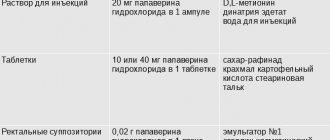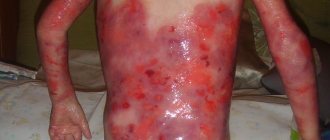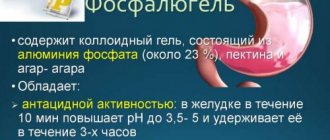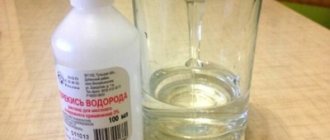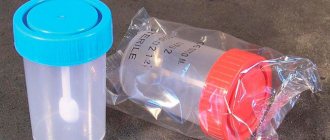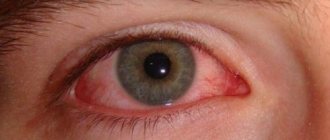General reactions:
- from the nervous system and sensory organs - dizziness and headaches, confusion, hallucinations, euphoria, paralysis of accommodation, disturbances of tactile sensations
- from the heart and blood vessels - ventricular and sinus tachycardia, myocardial ischemia, ventricular fibrillation
- from the gastrointestinal tract - intestinal atony, constipation, dry oral mucosa
- other adverse reactions - fever, urinary retention, photophobia
Local reactions:
- tingling sensation in the eyes, increased intraocular pressure
- irritation of the eyelids, hyperemia of the mucous membranes of the eye
- conjunctivitis
- paralysis of accommodation (pupil dilation)
With single administrations of a dose of atropine not exceeding 0.5 mg, paradoxical reactions from the parasympathetic nervous system, such as bradycardia and slowing of myocardial conduction, cannot be excluded. Atropine also reduces the pharmacological activity of m-cholinomimetics (for example, muscarine) and anticholinesterase drugs (physostigmine, proserine, etc.). The side effects of atropine are enhanced by the simultaneous use of tricyclic antidepressants, phenothiazines, antihistamines and other drugs with m-anticholinergic properties.
Narcotic effect
Atropine-containing drugs are anticholinergics widely used for recreational purposes. The narcotic effect is due to the high affinity of atropine for cholinergic receptors, which prevents their interaction with acetylcholine, a natural neurotransmitter. This leads to its accumulation in the synaptic cleft, inhibition of a number of parasympathetic effects and the functioning of the central nervous system with a predominance of adrenergic functions. As a result of this influence, various effects develop, the leading of which are hallucinogenic and psychomimetic.
Exceeding the dose of atropine leads to slight dizziness, muscle relaxation, a feeling of pleasant warmth throughout the body, and a hypomanic euphoric affect. The picture of drug intoxication with atropine is similar to the abuse of hashish or marijuana. To achieve euphoria, a person’s attitude towards the appropriate effect is important. The condition can last for several hours, after which the effect of the alkaloid decreases and a gradual withdrawal from it occurs. After drug intoxication, severe weakness, fatigue, a “drunk” or unsteady gait, headaches, and problems with the gastrointestinal tract are noted. If high doses of atropine were consumed, psychosis and metamorphopsia (motor agitation, exposure of the body, etc.) are observed.
The clinical picture of psychosis is characterized by symptoms of delirium (blurred consciousness, mental disorders, coma), cyanosis of the lips, pinpoint bruises in the forehead and chest, tachycardia, severe mydriasis and surges in blood pressure are often recorded. On average, acute psychosis lasts no more than 24 hours. Further, its residual manifestations may be unmotivated fears and increased anxiety, sleep disturbances. After a few days, these symptoms completely disappear.
Atropine
special instructions
Use with caution in patients with diseases of the cardiovascular system, in which an increase in heart rate may be undesirable: atrial fibrillation, tachycardia, chronic heart failure, coronary artery disease, mitral stenosis, arterial hypertension, acute bleeding; with thyrotoxicosis (possible increased tachycardia); at elevated temperatures (may further increase due to suppression of the activity of the sweat glands); with reflux esophagitis, hiatal hernia, combined with reflux esophagitis (decreased motility of the esophagus and stomach and relaxation of the lower esophageal sphincter can slow down gastric emptying and increase gastroesophageal reflux through the sphincter with impaired function); for gastrointestinal diseases accompanied by obstruction - achalasia of the esophagus, pyloric stenosis (possibly decreased motility and tone, leading to obstruction and retention of gastric contents), intestinal atony in elderly or debilitated patients (possible development of obstruction), paralytic ileus; with an increase in intraocular pressure - closed-angle (mydriatic effect, leading to an increase in intraocular pressure, can cause an acute attack) and open-angle glaucoma (mydriatic effect can cause a slight increase in intraocular pressure; adjustment of therapy may be required); with nonspecific ulcerative colitis (high doses can inhibit intestinal motility, increasing the likelihood of paralytic intestinal obstruction, in addition, the manifestation or exacerbation of such a severe complication as toxic megacolon is possible); with dry mouth (long-term use may cause further increase in the severity of xerostomia); with liver failure (decreased metabolism) and renal failure (risk of side effects due to decreased excretion); for chronic lung diseases, especially in young children and weakened patients (a decrease in bronchial secretion can lead to thickening of secretions and the formation of plugs in the bronchi); with myasthenia gravis (the condition may worsen due to inhibition of the action of acetylcholine); prostatic hypertrophy without urinary tract obstruction, urinary retention or predisposition to it, or diseases accompanied by urinary tract obstruction (including bladder neck due to prostatic hypertrophy); with gestosis (possibly increased arterial hypertension); brain damage in children, cerebral palsy, Down's disease (reaction to anticholinergic drugs increases).
The interval between doses of atropine and antacids containing aluminum or calcium carbonate should be at least 1 hour.
With subconjunctival or parabulbar administration of atropine, the patient must be given a validol tablet under the tongue in order to reduce tachycardia.
Impact on the ability to drive vehicles and machinery
During the treatment period, the patient must be careful when driving vehicles and engaging in other potentially hazardous activities that require increased concentration, speed of psychomotor reactions and good vision.
Phases of poisoning
Intentional or accidental use of high doses of atropine leads to the development of acute poisoning. The condition develops within 15 minutes after taking the drug - its initial signs are dryness of the mucous membranes of the mouth and nose, thirst, hoarseness, hyperemia of the skin, and increased body temperature. Vomiting does not occur with atropine poisoning. The clinical picture of intoxication is divided into two phases, which are based on the effect of atropine on the central nervous system. Let's take a closer look at them.
Psychomotor agitation
Characterized by progressive disorders of the central nervous system. On the part of the eyes, mydriasis with residual reactions to light, photophobia, increased intraocular pressure, double vision before the eyes, and decreased visual acuity are observed. The person feels dizzy and increasingly intoxicated.
Psychomotor agitation progresses. The victim literally rushes about, tries to run away, reacts inadequately to what is happening with strange laughter, shouts, and tears. Against this background, hallucinations appear and intensify - both visual and tactile, symptoms of delirium, ataxia, and disorientation in space and time arise.
The stimulating effect on the central nervous system is complicated by pyramidal insufficiency, namely hypertonicity of muscles, tendon and pathological reflexes (Oppenheim, Babinsky). In extremely severe cases of poisoning, confusion, acute signs of psychosis, convulsions, and epileptic seizures are observed already at the first stage.
CNS depression
Begins 10 hours after consuming a high dose of atropine. Characterized by depression of the central nervous system. A person experiences confusion, even to the point of developing coma, tendon reflexes fade, and muscle weakness increases.
With atropine intoxication, pictures of delirium with pronounced agitation and changeable affect appear, as well as states of stupor, turning into stupor and coma. Atropine intoxication is often accompanied by tachycardia, dry mouth, mydriasis, paralysis of accommodation, trembling, and twitching in certain muscle groups.”
cscb.su
With severe poisoning, depression of the central nervous system manifests itself extremely sharply. In this case, the first phase of psychomotor excitation may be completely absent. After taking a toxic dose of atropine, a person experiences drowsiness and falls into deep sleep, against the background of which dyspnea and bradypnea appear - serious problems with breathing and cardiac activity. The condition is dangerous due to the development of cyanosis and asphyxia, pulmonary and cerebral edema. The mortality rate of patients in this case is high - the causes of death are respiratory arrest and acute cardiovascular failure.
How to properly administer atropine to children
When selecting glasses for children, “atropinization” is necessary. In this case, a solution of atropine is instilled into the child’s eyes (or eyes) for several days or even weeks, at the rate of 1 drop twice a day.
It is known that improper use of medications can cause poisoning. When using an atropine solution, this is also possible. The first signs of poisoning with this substance are: dry mouth and facial flushing.
To avoid poisoning during atropinization, a number of precautions must be observed.
Thus, the drug can be stored in the refrigerator without freezing. At the same time, it must be prevented that the solution gets on the products. In addition, it is necessary to ensure that no one accidentally drinks the solution.
Any fluid is removed from the eye through the lacrimal ducts directly into the nasal cavity. In the nose, the medicine is absorbed into the blood, which threatens its adverse effects. The lacrimal ducts originate in the inner corner of the eye fissure. Therefore, doctors recommend that after instilling solutions of eye drops, press the lacrimal canaliculi with your finger to prevent the medicine from penetrating into the nasal cavity. In most cases, parents do this ineptly, so it has no effect. However, there is another way to administer solutions of potent drugs to children. Namely:
- You need to place the child face up (on a bed or sofa);
- Turn his head towards the eye into which the drops need to be instilled. In this case, the outer (temporal) corner of the eye will be lower than the inner one with the lacrimal opening, located at the bridge of the nose.
- The lower eyelid is pulled back and 1 drop of solution is instilled inside, into the area of the conjunctival sac closest to the temple. If the child closes his eyes sharply and the medicine flows out, you can drip a second drop.
- The eyelid is held retracted for a few seconds and then released. Excess medicine flows onto the temple, where it can be wiped off with a napkin.
- If it is necessary to instill the medicine into both eyes, the procedure is repeated with the head turned in the opposite direction.
To reduce the likelihood of even very mild poisoning to zero, drops should be instilled after meals, after 5-10 minutes (with 2 times daily instillation, this is done after breakfast and then after dinner).
The vast majority of drugs are excreted from the body through urine. Therefore, when performing atropinization, children must drink more (water, juice, jelly, milk, compote, tea).
If instillation of atropine solution into one eye is prescribed, unpleasant sensations may occur due to impaired binocular vision. At the same time, some children experience double vision, nausea and vomiting, and attacks of dizziness. This condition can be easily avoided if you simply cover one eye, for example, with a bandage.
Experience shows that parents who follow these rules during the period of atropinization do not have problems.
In the medical department, everyone can undergo examination using the most modern diagnostic equipment, and based on the results, receive advice from a highly qualified specialist. We are open seven days a week and work daily from 9 a.m. to 9 p.m. Our specialists will help identify the cause of vision loss and provide treatment for identified pathologies. Experienced refractive surgeons, detailed diagnostics and examination, as well as the extensive professional experience of our specialists ensure a favorable outcome for the patient.
You can find out the cost of a particular procedure and make an appointment at the Moscow Eye Clinic by calling multi-line phone 8 (daily from 9:00 to 21:00, free for mobile phones and regions of the Russian Federation) or by filling out the online registration form.


